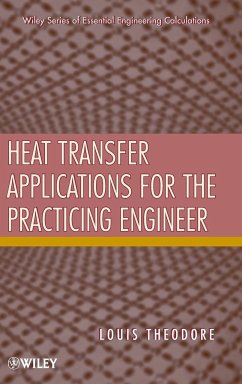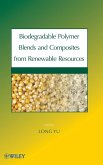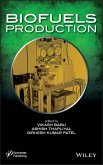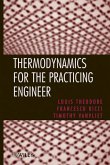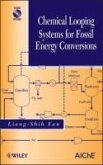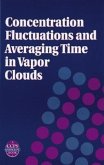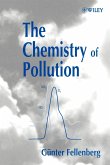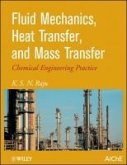Louis Theodore
Heat Transfer
Louis Theodore
Heat Transfer
- Gebundenes Buch
- Merkliste
- Auf die Merkliste
- Bewerten Bewerten
- Teilen
- Produkt teilen
- Produkterinnerung
- Produkterinnerung
This book serves as a training tool for individuals in industry and academia involved with heat transfer applications. Although the literature is inundated with texts emphasizing theory and theoretical derivations, the goal of this book is to present the subject of heat transfer from a strictly pragmatic point of view. The book is divided into four Parts: Introduction, Principles, Equipment Design Procedures and Applications, and ABET-related Topics. The first Part provides a series of chapters concerned with introductory topics that are required when solving most engineering problems,…mehr
Andere Kunden interessierten sich auch für
![Biodegradable Polymer Blends Biodegradable Polymer Blends]() Long YuBiodegradable Polymer Blends194,99 €
Long YuBiodegradable Polymer Blends194,99 €![Biofuels Production Biofuels Production]() Vikash BabuBiofuels Production241,99 €
Vikash BabuBiofuels Production241,99 €![Thermodynamics for the Practicing Engineer Thermodynamics for the Practicing Engineer]() Louis TheodoreThermodynamics for the Practicing Engineer163,99 €
Louis TheodoreThermodynamics for the Practicing Engineer163,99 €![Chemical Looping Systems for Fossil Energy Conversions Chemical Looping Systems for Fossil Energy Conversions]() Liang-Shih FanChemical Looping Systems for Fossil Energy Conversions143,99 €
Liang-Shih FanChemical Looping Systems for Fossil Energy Conversions143,99 €![Concentration Fluctuations and Averaging Time in Vapor Clouds Concentration Fluctuations and Averaging Time in Vapor Clouds]() David J WilsonConcentration Fluctuations and Averaging Time in Vapor Clouds182,99 €
David J WilsonConcentration Fluctuations and Averaging Time in Vapor Clouds182,99 €![The Chemistry of Pollution The Chemistry of Pollution]() Günter FellenbergThe Chemistry of Pollution173,99 €
Günter FellenbergThe Chemistry of Pollution173,99 €![Fluid Mechanics, Heat Transfer, and Mass Transfer Fluid Mechanics, Heat Transfer, and Mass Transfer]() K S RajuFluid Mechanics, Heat Transfer, and Mass Transfer206,99 €
K S RajuFluid Mechanics, Heat Transfer, and Mass Transfer206,99 €-
-
-
This book serves as a training tool for individuals in industry and academia involved with heat transfer applications. Although the literature is inundated with texts emphasizing theory and theoretical derivations, the goal of this book is to present the subject of heat transfer from a strictly pragmatic point of view. The book is divided into four Parts: Introduction, Principles, Equipment Design Procedures and Applications, and ABET-related Topics. The first Part provides a series of chapters concerned with introductory topics that are required when solving most engineering problems, including those in heat transfer. The second Part of the book is concerned with heat transfer principles. Topics that receive treatment include Steady-state Heat Conduction, Unsteady-state Heat Conduction, Forced Convection, Free Convection, Radiation, Boiling and Condensation, and Cryogenics. Part three (considered the heart of the book) addresses heat transfer equipment design procedures and applications. In addition to providing a detailed treatment of the various types of heat exchangers, this part also examines the impact of entropy calculations on exchanger design, and operation, maintenance and inspection (OM&I), plus refractory and insulation effects. The concluding Part of the text examines ABET (Accreditation Board for Engineering and Technology) related topics of concern, including economies and finance, numerical methods, open-ended problems, ethics, environmental management, and safety and accident management.
Hinweis: Dieser Artikel kann nur an eine deutsche Lieferadresse ausgeliefert werden.
Hinweis: Dieser Artikel kann nur an eine deutsche Lieferadresse ausgeliefert werden.
Produktdetails
- Produktdetails
- Verlag: John Wiley & Sons / Wiley
- Seitenzahl: 664
- Erscheinungstermin: 15. November 2011
- Englisch
- Abmessung: 240mm x 161mm x 40mm
- Gewicht: 1150g
- ISBN-13: 9780470643723
- ISBN-10: 0470643722
- Artikelnr.: 33392424
- Herstellerkennzeichnung
- Libri GmbH
- Europaallee 1
- 36244 Bad Hersfeld
- gpsr@libri.de
- Verlag: John Wiley & Sons / Wiley
- Seitenzahl: 664
- Erscheinungstermin: 15. November 2011
- Englisch
- Abmessung: 240mm x 161mm x 40mm
- Gewicht: 1150g
- ISBN-13: 9780470643723
- ISBN-10: 0470643722
- Artikelnr.: 33392424
- Herstellerkennzeichnung
- Libri GmbH
- Europaallee 1
- 36244 Bad Hersfeld
- gpsr@libri.de
Louis Theodore EngScD, a professor of chemical engineering for fifty years, is the author of many Wiley books, including Fluid Flow for the Practicing Chemical Engineer, Thermodynamics for the Practicing Engineer, and Mass Transfer Operations for the Practicing Engineer. He is also a contributor and Section Editor to Perry's Chemical Engineers' Handbook and coauthor of Introduction to Hazardous Waste Incineration, Second Edition, which is also published by Wiley. Dr. Theodore is currently a consultant to Theodore Tutorials, located in East Williston, New York.
Preface xv
Introductory Comments xvii
Part One Introduction
1. History of Heat Transfer 3
Introduction 3
Peripheral Equipment 4
Recent History 5
References 6
2. History of Chemical Engineering: Transport Phenomena vs Unit Operations
7
Introduction 7
History of Chemical Engineering 8
Transport Phenomena vs Unit Operations 10
What is Engineering? 12
References 13
3. Process Variables 15
Introduction 15
Units and Dimensional Consistency 16
Key Terms and Definitions 19
Fluids 19
Temperature 19
Pressure 20
Moles and Molecular Weights 22
Mass and Volume 23
Viscosity 25
Heat Capacity 27
Thermal Conductivity 28
Thermal Diffusivity 30
Reynolds Number 30
Kinetic Energy 31
Potential Energy 32
Determination of Dimensionless Groups 33
References 36
4. Conservation Laws 37
Introduction 37
The Conservation Laws 38
The Conservation Law for Momentum 38
The Conservation Law for Mass 40
The Conservation Law for Energy 45
References 54
5. Gas Laws 55
Introduction 55
Boyle's and Charles' Laws 56
The Ideal Gas Law 57
Standard Conditions 60
Partial Pressure and Partial Volume 63
Non-Ideal Gas Behavior 65
References 65
6. Heat Exchanger Pipes and Tubes 67
Introduction 67
Pipes 67
Tubes 73
Valves and Fittings 75
Valves 75
Fittings 77
Noncircular Conduits 78
Flow Considerations 80
References 83
Part Two Principles
7. Steady-State Heat Conduction 87
Introduction 87
Fourier's Law 87
Conductivity Resistances 90
Microscopic Approach 99
Applications 102
References 114
8. Unsteady-State Heat Conduction 115
Introduction 115
Classification of Unsteady-State Heat Conduction Processes 116
Microscopic Equations 117
Applications 118
References 130
9. Forced Convection 131
Introduction 131
Convective Resistances 134
Heat Transfer Coefficients: Qualitative Information 137
Heat Transfer Coefficients: Quantitative Information 138
Flow Past a Flat Plate 141
Flow in a Circular Tube 146
Liquid Metal Flow in a Circular Tube 147
Convection Across Cylinders 148
Microscopic Approach 155
References 159
10. Free Convection 161
Introduction 161
Key Dimensionless Numbers 162
Describing Equations 164
Environmental Applications 171
Lapse Rates 171
Plume Rise 173
References 176
11. Radiation 177
Introduction 177
Energy and Intensity 180
Radiant Exchange 183
Kirchoff's Law 184
Emissivity Factors 189
View Factors 196
References 200
12. Condensation and Boiling 201
Introduction 201
Condensation Fundamentals 203
Phase Equilibrium 205
Psychrometric Chart 207
Steam Tables 208
Condensation Principles 209
Boiling Fundamentals 215
Boiling Principles 218
References 225
13. Refrigeration and Cryogenics 227
Introduction 227
Background Material 228
Refrigeration 228
Cryogenics 230
Liquefaction 231
Cryogens 232
Equipment 234
Typical Heat Exchangers 234
Materials of Construction 235
Insulation and Heat Loss 236
Storage and Transportation 240
Hazards, Risks, and Safety 241
Physiological Hazards 241
Physical Hazards 242
Chemical Hazards 244
Basic Principles and Applications 244
Coefficient of Performance 246
Thermal Efficiency 248
Entropy and Heat 252
References 253
Part Three Heat Transfer Equipment Design Procedures and Applications
14. Introduction to Heat Exchangers 257
Introduction 257
Energy Relationships 258
Heat Exchange Equipment Classification 260
The Log Mean Temperature Difference (LMTD) Driving Force 262
Temperature Profiles 265
Overall Heat Transfer Coefficients 268
Fouling Factors 271
The Controlling Resistance 272
Varying Overall Heat Transfer Coefficients 276
The Heat Transfer Equation 278
References 279
15. Double Pipe Heat Exchangers 281
Introduction 281
Equipment Description 282
Describing Equations 286
Calculation of Exit Temperatures 298
Effectiveness Factor and Number of Transfer Units 304
Wilson's Method 309
References 313
16. Shell and Tube Heat Exchangers 315
Introduction 315
Equipment Description 316
Describing Equations 322
The "F" Factor 328
Effectiveness Factor and Number of Transfer Units 344
References 356
17. Fins and Extended Surfaces 357
Introduction 357
Fin Types 358
Describing Equations 360
Fin Effectiveness and Performance 371
Fin Considerations 380
References 380
18. Other Heat Exchange Equipment 381
Introduction 381
Evaporators 382
Mixing Effects 384
Waste Heat Boilers 392
Describing Equations 394
Condensers 401
Quenchers 404
Dilution with Ambient Air 405
Quenching with Liquids 405
Contact with High Heat Capacity Solids 405
Natural Convection and Radiation 406
Forced-Draft Cooling 406
References 410
19. Insulation and Refractory 411
Introduction 411
Describing Equations 411
Insulation 430
Critical Insulation Thickness 431
Refractory 435
References 442
20. Operation, Maintenance, and Inspection (OM&I) 443
Introduction 443
Installation Procedures 443
Clearance Provisions 444
Foundations 444
Leveling 444
Piping Considerations 444
Operation 445
Startup 446
Shut Down 446
Maintenance and Inspection 446
Cleaning 446
Testing 447
Improving Operation and Performance 448
References 449
21. Entropy Considerations and Analysis 451
Introduction 451
Qualitative Review of the Second Law 452
Describing Equations 453
The Heat Exchanger Dilemma 455
Applications 460
References 463
22. Design Principles and Industrial Applications 465
Introduction 465
General Design Procedures 466
Process Schematics 467
Purchasing a Heat Exchanger 468
Applications 470
References 490
Part Four Special Topics
23. Environmental Management 493
Introduction 493
Environmental Management History 493
Environmental Management Topics 495
Applications 496
References 503
24. Accident and Emergency Management 505
Introduction 505
Legislation 506
Comprehensive Environmental Response, Compensation, and Liability Act
(CERCLA) 506
Superfund Amendments and Reauthorization Act of 1986 (SARA) 507
Occupational Safety and Health Act (OSHA) 508
USEPA's Risk Management Program (RMP) 509
Hazard Risk Assessment 510
Applications 513
References 531
25. Ethics 533
Introduction 533
Teaching Ethics 534
The Case Study Approach 535
Applications 537
References 540
26. Numerical Methods 541
Introduction 541
History 542
Partial Differential Equations (PDE) 544
Parabolic PDE 545
Elliptical PDE 546
Regresion Analysis 554
Correlation Coefficient 557
Optimization 560
Perturbation Studies in Optimization 560
References 562
27. Economics and Finance 563
Introduction 563
The Need for Economic Analyses 563
Definitions 565
Simple Interest 565
Compound Interest 565
Present Worth 566
Evaluation of Sums of Money 566
Depreciation 567
Fabricated Equipment Cost Index 567
Capital Recovery Factor 567
Present Net Worth 568
Perpetual Life 568
Break-Even Point 569
Approximate Rate of Return 569
Exact Rate of Return 569
Bonds 570
Incremental Cost 570
Optimization 570
Principles of Accounting 571
Applications 573
References 588
28. Open-Ended Problems 589
Introduction 589
Developing Students' Power of Critical Thinking 592
Creativity 592
Brainstorming 593
Inquiring Minds 594
Applications 594
References 602
Appendix A. Units 603
Appendix B. Tables 613
Appendix C. Figures 627
Appendix D. Steam Tables 631
Index 639
Introductory Comments xvii
Part One Introduction
1. History of Heat Transfer 3
Introduction 3
Peripheral Equipment 4
Recent History 5
References 6
2. History of Chemical Engineering: Transport Phenomena vs Unit Operations
7
Introduction 7
History of Chemical Engineering 8
Transport Phenomena vs Unit Operations 10
What is Engineering? 12
References 13
3. Process Variables 15
Introduction 15
Units and Dimensional Consistency 16
Key Terms and Definitions 19
Fluids 19
Temperature 19
Pressure 20
Moles and Molecular Weights 22
Mass and Volume 23
Viscosity 25
Heat Capacity 27
Thermal Conductivity 28
Thermal Diffusivity 30
Reynolds Number 30
Kinetic Energy 31
Potential Energy 32
Determination of Dimensionless Groups 33
References 36
4. Conservation Laws 37
Introduction 37
The Conservation Laws 38
The Conservation Law for Momentum 38
The Conservation Law for Mass 40
The Conservation Law for Energy 45
References 54
5. Gas Laws 55
Introduction 55
Boyle's and Charles' Laws 56
The Ideal Gas Law 57
Standard Conditions 60
Partial Pressure and Partial Volume 63
Non-Ideal Gas Behavior 65
References 65
6. Heat Exchanger Pipes and Tubes 67
Introduction 67
Pipes 67
Tubes 73
Valves and Fittings 75
Valves 75
Fittings 77
Noncircular Conduits 78
Flow Considerations 80
References 83
Part Two Principles
7. Steady-State Heat Conduction 87
Introduction 87
Fourier's Law 87
Conductivity Resistances 90
Microscopic Approach 99
Applications 102
References 114
8. Unsteady-State Heat Conduction 115
Introduction 115
Classification of Unsteady-State Heat Conduction Processes 116
Microscopic Equations 117
Applications 118
References 130
9. Forced Convection 131
Introduction 131
Convective Resistances 134
Heat Transfer Coefficients: Qualitative Information 137
Heat Transfer Coefficients: Quantitative Information 138
Flow Past a Flat Plate 141
Flow in a Circular Tube 146
Liquid Metal Flow in a Circular Tube 147
Convection Across Cylinders 148
Microscopic Approach 155
References 159
10. Free Convection 161
Introduction 161
Key Dimensionless Numbers 162
Describing Equations 164
Environmental Applications 171
Lapse Rates 171
Plume Rise 173
References 176
11. Radiation 177
Introduction 177
Energy and Intensity 180
Radiant Exchange 183
Kirchoff's Law 184
Emissivity Factors 189
View Factors 196
References 200
12. Condensation and Boiling 201
Introduction 201
Condensation Fundamentals 203
Phase Equilibrium 205
Psychrometric Chart 207
Steam Tables 208
Condensation Principles 209
Boiling Fundamentals 215
Boiling Principles 218
References 225
13. Refrigeration and Cryogenics 227
Introduction 227
Background Material 228
Refrigeration 228
Cryogenics 230
Liquefaction 231
Cryogens 232
Equipment 234
Typical Heat Exchangers 234
Materials of Construction 235
Insulation and Heat Loss 236
Storage and Transportation 240
Hazards, Risks, and Safety 241
Physiological Hazards 241
Physical Hazards 242
Chemical Hazards 244
Basic Principles and Applications 244
Coefficient of Performance 246
Thermal Efficiency 248
Entropy and Heat 252
References 253
Part Three Heat Transfer Equipment Design Procedures and Applications
14. Introduction to Heat Exchangers 257
Introduction 257
Energy Relationships 258
Heat Exchange Equipment Classification 260
The Log Mean Temperature Difference (LMTD) Driving Force 262
Temperature Profiles 265
Overall Heat Transfer Coefficients 268
Fouling Factors 271
The Controlling Resistance 272
Varying Overall Heat Transfer Coefficients 276
The Heat Transfer Equation 278
References 279
15. Double Pipe Heat Exchangers 281
Introduction 281
Equipment Description 282
Describing Equations 286
Calculation of Exit Temperatures 298
Effectiveness Factor and Number of Transfer Units 304
Wilson's Method 309
References 313
16. Shell and Tube Heat Exchangers 315
Introduction 315
Equipment Description 316
Describing Equations 322
The "F" Factor 328
Effectiveness Factor and Number of Transfer Units 344
References 356
17. Fins and Extended Surfaces 357
Introduction 357
Fin Types 358
Describing Equations 360
Fin Effectiveness and Performance 371
Fin Considerations 380
References 380
18. Other Heat Exchange Equipment 381
Introduction 381
Evaporators 382
Mixing Effects 384
Waste Heat Boilers 392
Describing Equations 394
Condensers 401
Quenchers 404
Dilution with Ambient Air 405
Quenching with Liquids 405
Contact with High Heat Capacity Solids 405
Natural Convection and Radiation 406
Forced-Draft Cooling 406
References 410
19. Insulation and Refractory 411
Introduction 411
Describing Equations 411
Insulation 430
Critical Insulation Thickness 431
Refractory 435
References 442
20. Operation, Maintenance, and Inspection (OM&I) 443
Introduction 443
Installation Procedures 443
Clearance Provisions 444
Foundations 444
Leveling 444
Piping Considerations 444
Operation 445
Startup 446
Shut Down 446
Maintenance and Inspection 446
Cleaning 446
Testing 447
Improving Operation and Performance 448
References 449
21. Entropy Considerations and Analysis 451
Introduction 451
Qualitative Review of the Second Law 452
Describing Equations 453
The Heat Exchanger Dilemma 455
Applications 460
References 463
22. Design Principles and Industrial Applications 465
Introduction 465
General Design Procedures 466
Process Schematics 467
Purchasing a Heat Exchanger 468
Applications 470
References 490
Part Four Special Topics
23. Environmental Management 493
Introduction 493
Environmental Management History 493
Environmental Management Topics 495
Applications 496
References 503
24. Accident and Emergency Management 505
Introduction 505
Legislation 506
Comprehensive Environmental Response, Compensation, and Liability Act
(CERCLA) 506
Superfund Amendments and Reauthorization Act of 1986 (SARA) 507
Occupational Safety and Health Act (OSHA) 508
USEPA's Risk Management Program (RMP) 509
Hazard Risk Assessment 510
Applications 513
References 531
25. Ethics 533
Introduction 533
Teaching Ethics 534
The Case Study Approach 535
Applications 537
References 540
26. Numerical Methods 541
Introduction 541
History 542
Partial Differential Equations (PDE) 544
Parabolic PDE 545
Elliptical PDE 546
Regresion Analysis 554
Correlation Coefficient 557
Optimization 560
Perturbation Studies in Optimization 560
References 562
27. Economics and Finance 563
Introduction 563
The Need for Economic Analyses 563
Definitions 565
Simple Interest 565
Compound Interest 565
Present Worth 566
Evaluation of Sums of Money 566
Depreciation 567
Fabricated Equipment Cost Index 567
Capital Recovery Factor 567
Present Net Worth 568
Perpetual Life 568
Break-Even Point 569
Approximate Rate of Return 569
Exact Rate of Return 569
Bonds 570
Incremental Cost 570
Optimization 570
Principles of Accounting 571
Applications 573
References 588
28. Open-Ended Problems 589
Introduction 589
Developing Students' Power of Critical Thinking 592
Creativity 592
Brainstorming 593
Inquiring Minds 594
Applications 594
References 602
Appendix A. Units 603
Appendix B. Tables 613
Appendix C. Figures 627
Appendix D. Steam Tables 631
Index 639
Preface xv
Introductory Comments xvii
Part One Introduction
1. History of Heat Transfer 3
Introduction 3
Peripheral Equipment 4
Recent History 5
References 6
2. History of Chemical Engineering: Transport Phenomena vs Unit Operations
7
Introduction 7
History of Chemical Engineering 8
Transport Phenomena vs Unit Operations 10
What is Engineering? 12
References 13
3. Process Variables 15
Introduction 15
Units and Dimensional Consistency 16
Key Terms and Definitions 19
Fluids 19
Temperature 19
Pressure 20
Moles and Molecular Weights 22
Mass and Volume 23
Viscosity 25
Heat Capacity 27
Thermal Conductivity 28
Thermal Diffusivity 30
Reynolds Number 30
Kinetic Energy 31
Potential Energy 32
Determination of Dimensionless Groups 33
References 36
4. Conservation Laws 37
Introduction 37
The Conservation Laws 38
The Conservation Law for Momentum 38
The Conservation Law for Mass 40
The Conservation Law for Energy 45
References 54
5. Gas Laws 55
Introduction 55
Boyle's and Charles' Laws 56
The Ideal Gas Law 57
Standard Conditions 60
Partial Pressure and Partial Volume 63
Non-Ideal Gas Behavior 65
References 65
6. Heat Exchanger Pipes and Tubes 67
Introduction 67
Pipes 67
Tubes 73
Valves and Fittings 75
Valves 75
Fittings 77
Noncircular Conduits 78
Flow Considerations 80
References 83
Part Two Principles
7. Steady-State Heat Conduction 87
Introduction 87
Fourier's Law 87
Conductivity Resistances 90
Microscopic Approach 99
Applications 102
References 114
8. Unsteady-State Heat Conduction 115
Introduction 115
Classification of Unsteady-State Heat Conduction Processes 116
Microscopic Equations 117
Applications 118
References 130
9. Forced Convection 131
Introduction 131
Convective Resistances 134
Heat Transfer Coefficients: Qualitative Information 137
Heat Transfer Coefficients: Quantitative Information 138
Flow Past a Flat Plate 141
Flow in a Circular Tube 146
Liquid Metal Flow in a Circular Tube 147
Convection Across Cylinders 148
Microscopic Approach 155
References 159
10. Free Convection 161
Introduction 161
Key Dimensionless Numbers 162
Describing Equations 164
Environmental Applications 171
Lapse Rates 171
Plume Rise 173
References 176
11. Radiation 177
Introduction 177
Energy and Intensity 180
Radiant Exchange 183
Kirchoff's Law 184
Emissivity Factors 189
View Factors 196
References 200
12. Condensation and Boiling 201
Introduction 201
Condensation Fundamentals 203
Phase Equilibrium 205
Psychrometric Chart 207
Steam Tables 208
Condensation Principles 209
Boiling Fundamentals 215
Boiling Principles 218
References 225
13. Refrigeration and Cryogenics 227
Introduction 227
Background Material 228
Refrigeration 228
Cryogenics 230
Liquefaction 231
Cryogens 232
Equipment 234
Typical Heat Exchangers 234
Materials of Construction 235
Insulation and Heat Loss 236
Storage and Transportation 240
Hazards, Risks, and Safety 241
Physiological Hazards 241
Physical Hazards 242
Chemical Hazards 244
Basic Principles and Applications 244
Coefficient of Performance 246
Thermal Efficiency 248
Entropy and Heat 252
References 253
Part Three Heat Transfer Equipment Design Procedures and Applications
14. Introduction to Heat Exchangers 257
Introduction 257
Energy Relationships 258
Heat Exchange Equipment Classification 260
The Log Mean Temperature Difference (LMTD) Driving Force 262
Temperature Profiles 265
Overall Heat Transfer Coefficients 268
Fouling Factors 271
The Controlling Resistance 272
Varying Overall Heat Transfer Coefficients 276
The Heat Transfer Equation 278
References 279
15. Double Pipe Heat Exchangers 281
Introduction 281
Equipment Description 282
Describing Equations 286
Calculation of Exit Temperatures 298
Effectiveness Factor and Number of Transfer Units 304
Wilson's Method 309
References 313
16. Shell and Tube Heat Exchangers 315
Introduction 315
Equipment Description 316
Describing Equations 322
The "F" Factor 328
Effectiveness Factor and Number of Transfer Units 344
References 356
17. Fins and Extended Surfaces 357
Introduction 357
Fin Types 358
Describing Equations 360
Fin Effectiveness and Performance 371
Fin Considerations 380
References 380
18. Other Heat Exchange Equipment 381
Introduction 381
Evaporators 382
Mixing Effects 384
Waste Heat Boilers 392
Describing Equations 394
Condensers 401
Quenchers 404
Dilution with Ambient Air 405
Quenching with Liquids 405
Contact with High Heat Capacity Solids 405
Natural Convection and Radiation 406
Forced-Draft Cooling 406
References 410
19. Insulation and Refractory 411
Introduction 411
Describing Equations 411
Insulation 430
Critical Insulation Thickness 431
Refractory 435
References 442
20. Operation, Maintenance, and Inspection (OM&I) 443
Introduction 443
Installation Procedures 443
Clearance Provisions 444
Foundations 444
Leveling 444
Piping Considerations 444
Operation 445
Startup 446
Shut Down 446
Maintenance and Inspection 446
Cleaning 446
Testing 447
Improving Operation and Performance 448
References 449
21. Entropy Considerations and Analysis 451
Introduction 451
Qualitative Review of the Second Law 452
Describing Equations 453
The Heat Exchanger Dilemma 455
Applications 460
References 463
22. Design Principles and Industrial Applications 465
Introduction 465
General Design Procedures 466
Process Schematics 467
Purchasing a Heat Exchanger 468
Applications 470
References 490
Part Four Special Topics
23. Environmental Management 493
Introduction 493
Environmental Management History 493
Environmental Management Topics 495
Applications 496
References 503
24. Accident and Emergency Management 505
Introduction 505
Legislation 506
Comprehensive Environmental Response, Compensation, and Liability Act
(CERCLA) 506
Superfund Amendments and Reauthorization Act of 1986 (SARA) 507
Occupational Safety and Health Act (OSHA) 508
USEPA's Risk Management Program (RMP) 509
Hazard Risk Assessment 510
Applications 513
References 531
25. Ethics 533
Introduction 533
Teaching Ethics 534
The Case Study Approach 535
Applications 537
References 540
26. Numerical Methods 541
Introduction 541
History 542
Partial Differential Equations (PDE) 544
Parabolic PDE 545
Elliptical PDE 546
Regresion Analysis 554
Correlation Coefficient 557
Optimization 560
Perturbation Studies in Optimization 560
References 562
27. Economics and Finance 563
Introduction 563
The Need for Economic Analyses 563
Definitions 565
Simple Interest 565
Compound Interest 565
Present Worth 566
Evaluation of Sums of Money 566
Depreciation 567
Fabricated Equipment Cost Index 567
Capital Recovery Factor 567
Present Net Worth 568
Perpetual Life 568
Break-Even Point 569
Approximate Rate of Return 569
Exact Rate of Return 569
Bonds 570
Incremental Cost 570
Optimization 570
Principles of Accounting 571
Applications 573
References 588
28. Open-Ended Problems 589
Introduction 589
Developing Students' Power of Critical Thinking 592
Creativity 592
Brainstorming 593
Inquiring Minds 594
Applications 594
References 602
Appendix A. Units 603
Appendix B. Tables 613
Appendix C. Figures 627
Appendix D. Steam Tables 631
Index 639
Introductory Comments xvii
Part One Introduction
1. History of Heat Transfer 3
Introduction 3
Peripheral Equipment 4
Recent History 5
References 6
2. History of Chemical Engineering: Transport Phenomena vs Unit Operations
7
Introduction 7
History of Chemical Engineering 8
Transport Phenomena vs Unit Operations 10
What is Engineering? 12
References 13
3. Process Variables 15
Introduction 15
Units and Dimensional Consistency 16
Key Terms and Definitions 19
Fluids 19
Temperature 19
Pressure 20
Moles and Molecular Weights 22
Mass and Volume 23
Viscosity 25
Heat Capacity 27
Thermal Conductivity 28
Thermal Diffusivity 30
Reynolds Number 30
Kinetic Energy 31
Potential Energy 32
Determination of Dimensionless Groups 33
References 36
4. Conservation Laws 37
Introduction 37
The Conservation Laws 38
The Conservation Law for Momentum 38
The Conservation Law for Mass 40
The Conservation Law for Energy 45
References 54
5. Gas Laws 55
Introduction 55
Boyle's and Charles' Laws 56
The Ideal Gas Law 57
Standard Conditions 60
Partial Pressure and Partial Volume 63
Non-Ideal Gas Behavior 65
References 65
6. Heat Exchanger Pipes and Tubes 67
Introduction 67
Pipes 67
Tubes 73
Valves and Fittings 75
Valves 75
Fittings 77
Noncircular Conduits 78
Flow Considerations 80
References 83
Part Two Principles
7. Steady-State Heat Conduction 87
Introduction 87
Fourier's Law 87
Conductivity Resistances 90
Microscopic Approach 99
Applications 102
References 114
8. Unsteady-State Heat Conduction 115
Introduction 115
Classification of Unsteady-State Heat Conduction Processes 116
Microscopic Equations 117
Applications 118
References 130
9. Forced Convection 131
Introduction 131
Convective Resistances 134
Heat Transfer Coefficients: Qualitative Information 137
Heat Transfer Coefficients: Quantitative Information 138
Flow Past a Flat Plate 141
Flow in a Circular Tube 146
Liquid Metal Flow in a Circular Tube 147
Convection Across Cylinders 148
Microscopic Approach 155
References 159
10. Free Convection 161
Introduction 161
Key Dimensionless Numbers 162
Describing Equations 164
Environmental Applications 171
Lapse Rates 171
Plume Rise 173
References 176
11. Radiation 177
Introduction 177
Energy and Intensity 180
Radiant Exchange 183
Kirchoff's Law 184
Emissivity Factors 189
View Factors 196
References 200
12. Condensation and Boiling 201
Introduction 201
Condensation Fundamentals 203
Phase Equilibrium 205
Psychrometric Chart 207
Steam Tables 208
Condensation Principles 209
Boiling Fundamentals 215
Boiling Principles 218
References 225
13. Refrigeration and Cryogenics 227
Introduction 227
Background Material 228
Refrigeration 228
Cryogenics 230
Liquefaction 231
Cryogens 232
Equipment 234
Typical Heat Exchangers 234
Materials of Construction 235
Insulation and Heat Loss 236
Storage and Transportation 240
Hazards, Risks, and Safety 241
Physiological Hazards 241
Physical Hazards 242
Chemical Hazards 244
Basic Principles and Applications 244
Coefficient of Performance 246
Thermal Efficiency 248
Entropy and Heat 252
References 253
Part Three Heat Transfer Equipment Design Procedures and Applications
14. Introduction to Heat Exchangers 257
Introduction 257
Energy Relationships 258
Heat Exchange Equipment Classification 260
The Log Mean Temperature Difference (LMTD) Driving Force 262
Temperature Profiles 265
Overall Heat Transfer Coefficients 268
Fouling Factors 271
The Controlling Resistance 272
Varying Overall Heat Transfer Coefficients 276
The Heat Transfer Equation 278
References 279
15. Double Pipe Heat Exchangers 281
Introduction 281
Equipment Description 282
Describing Equations 286
Calculation of Exit Temperatures 298
Effectiveness Factor and Number of Transfer Units 304
Wilson's Method 309
References 313
16. Shell and Tube Heat Exchangers 315
Introduction 315
Equipment Description 316
Describing Equations 322
The "F" Factor 328
Effectiveness Factor and Number of Transfer Units 344
References 356
17. Fins and Extended Surfaces 357
Introduction 357
Fin Types 358
Describing Equations 360
Fin Effectiveness and Performance 371
Fin Considerations 380
References 380
18. Other Heat Exchange Equipment 381
Introduction 381
Evaporators 382
Mixing Effects 384
Waste Heat Boilers 392
Describing Equations 394
Condensers 401
Quenchers 404
Dilution with Ambient Air 405
Quenching with Liquids 405
Contact with High Heat Capacity Solids 405
Natural Convection and Radiation 406
Forced-Draft Cooling 406
References 410
19. Insulation and Refractory 411
Introduction 411
Describing Equations 411
Insulation 430
Critical Insulation Thickness 431
Refractory 435
References 442
20. Operation, Maintenance, and Inspection (OM&I) 443
Introduction 443
Installation Procedures 443
Clearance Provisions 444
Foundations 444
Leveling 444
Piping Considerations 444
Operation 445
Startup 446
Shut Down 446
Maintenance and Inspection 446
Cleaning 446
Testing 447
Improving Operation and Performance 448
References 449
21. Entropy Considerations and Analysis 451
Introduction 451
Qualitative Review of the Second Law 452
Describing Equations 453
The Heat Exchanger Dilemma 455
Applications 460
References 463
22. Design Principles and Industrial Applications 465
Introduction 465
General Design Procedures 466
Process Schematics 467
Purchasing a Heat Exchanger 468
Applications 470
References 490
Part Four Special Topics
23. Environmental Management 493
Introduction 493
Environmental Management History 493
Environmental Management Topics 495
Applications 496
References 503
24. Accident and Emergency Management 505
Introduction 505
Legislation 506
Comprehensive Environmental Response, Compensation, and Liability Act
(CERCLA) 506
Superfund Amendments and Reauthorization Act of 1986 (SARA) 507
Occupational Safety and Health Act (OSHA) 508
USEPA's Risk Management Program (RMP) 509
Hazard Risk Assessment 510
Applications 513
References 531
25. Ethics 533
Introduction 533
Teaching Ethics 534
The Case Study Approach 535
Applications 537
References 540
26. Numerical Methods 541
Introduction 541
History 542
Partial Differential Equations (PDE) 544
Parabolic PDE 545
Elliptical PDE 546
Regresion Analysis 554
Correlation Coefficient 557
Optimization 560
Perturbation Studies in Optimization 560
References 562
27. Economics and Finance 563
Introduction 563
The Need for Economic Analyses 563
Definitions 565
Simple Interest 565
Compound Interest 565
Present Worth 566
Evaluation of Sums of Money 566
Depreciation 567
Fabricated Equipment Cost Index 567
Capital Recovery Factor 567
Present Net Worth 568
Perpetual Life 568
Break-Even Point 569
Approximate Rate of Return 569
Exact Rate of Return 569
Bonds 570
Incremental Cost 570
Optimization 570
Principles of Accounting 571
Applications 573
References 588
28. Open-Ended Problems 589
Introduction 589
Developing Students' Power of Critical Thinking 592
Creativity 592
Brainstorming 593
Inquiring Minds 594
Applications 594
References 602
Appendix A. Units 603
Appendix B. Tables 613
Appendix C. Figures 627
Appendix D. Steam Tables 631
Index 639

